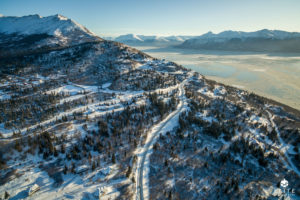
It looks good. Has tall trees. Even a view of the mountains and a peek-a-boo view of the inlet. But, what else do you need to know? First, does the current zoning allow for what you want to do with the property. Whether it is a potential tract for a new subdivision or an already platted lot, there are zoning restrictions that run with the parcel. You may want to build a triplex but the zoning only allows for a duplex. To build the triplex, you would need to rezone the property which would require a rezone application to the Planning and Zoning Commission for approval as well as to the assembly which has the final approval for all rezones. That process can take anywhere from six months to a year depending on the complexity of the rezone and the schedule of P and Z and the Anchorage Assembly.
Soils may look good initially with natural vegetation but we all know looks are deceiving so the careful buyer will want to have some test holes dug and the sample soils evaluated by professional engineers. Whether building a subdivision with roads/water/sewer or buying a lot to build a new home on, test holes can give you a good idea of the excavation costs and costs for the haul off of bad soils and the haul in of dry gravel. These extra costs do not add appraised value to the vertical structure you are planning on building. Are the easements for gas and electric on the front or back of the lot? Easements constrain placement of the structure. You also want to make sure you have the appropriate square footage available for your footprint. No more than 30% of a lot can be utilized for a two-story home and no more than 40% for a ranch. That lot coverage ratio includes porches and garages.
There are a number of infill vacant lots in Anchorage, particularly in the older parts of Anchorage. However, in most instances, water and sewer pigtails are not thru the right-of-way and so a buyer will need to tear up the street to connect to the water/sewer main. Even if by chance, the pigtails were extended through the right-of-way, they will most likely not be the right size or type material and will need to be replaced. Another cost that does not add value.
Will there by ‘off-site’ costs that you will have to pay to develop the property? Off-site costs can include a requirement to pave alleys which are common in older neighborhoods like South Addition and Mountain View. A neighbor may have water/sewer to his property but that doesn’t necessarily mean the main has been extended to your lot line. The same is true for gas and electric. The access to the property may look like a road but it may, instead, be a drive-way that will need to be improved road standards before you are allowed to build on your lot.
Finally, are there covenants, codes and restrictions on the property? Even if they are forty years old and by all appearances have been violated numerous times over the years, read them carefully. There is always a pesky neighbor who may not like you building on that vacant lot they’ve used as open space for several years.

 Connie Yoshimura is the Owner and Broker of Berkshire Hathaway HomeServices Alaska Realty. With over 40 years of residential real estate experience, she continues to be a leader in Alaska’s housing market. Most recently, she sold the highest-priced home ever recorded in the Alaska MLS.
Connie Yoshimura is the Owner and Broker of Berkshire Hathaway HomeServices Alaska Realty. With over 40 years of residential real estate experience, she continues to be a leader in Alaska’s housing market. Most recently, she sold the highest-priced home ever recorded in the Alaska MLS.
Leave a Reply